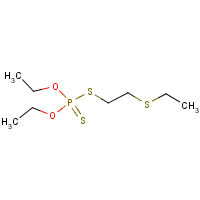Disulfoton
Agent Name
Disulfoton
CAS Number
298-04-4
Formula
C8-H19-O2-P-S3
Major Category
Pesticides

Synonyms
BAY 19639; Bayer 19639; Di-Syston G; Di-syston; Disulfoton; Dithiodemeton; Dithiophosphate de O,O-diethyle et de S-(2-ethylthio-ethyle) [French]; Dithiosystox; Dution; Ekatin TD; Ekatine; Ethyl thiometon; Ethylthiometon B; Frumin; Frumin AL; Frumin G; Glebofos; Insyst-D; M-74; M-74 (Pesticide); O,O-Diaethyl-S-(2-aethylthio-aethyl)-dithiophosphat [German]; O,O-Diaethyl-S-(3-thia-pentyl)-dithiophosphat [German]; O,O-Diethyl 2-ethylthioethyl phosphorodithioate; O,O-Diethyl S-(2-(ethylthio)ethyl) dithiophosphate; O,O-Diethyl S-(2-(ethylthio)ethyl)phosphorodithioate; O,O-Diethyl S-(2-eththioethyl) phosphorodithioate; O,O-Diethyl S-(2-eththioethyl) thiothionophosphate; O,O-Diethyl S-(2-ethylmercaptoethyl) dithiophosphate; O,O-Diethyl S-2-(ethylthio)ethyl phosphorodithioate; O,O-Diethyl-S-(2-ethylthio-ethyl)-dithiofosfaat [Dutch]; O,O-Diethyl-S-ethylmercapto-ethyl dithiophosphate; O,O-Dietil-S-(2-etiltio-etil)-ditiofosfato [Italian]; S 276; S-2-(Ethylthio)ethyl O,O-diethyl ester of phosphorodithioic acid; Solvigran; Solvirex; Thiodemeton; Vuagt 1-4; Vuagt 1964; [ChemIDplus]
Category
Organophosphate Insecticides
Description
Oily, colorless to yellow liquid with a characteristic, sulfur odor. [insecticide] [Note: Technical product is a brown liquid.]; [NIOSH]
Sources/Uses
Used on cotton, tobacco, sugar beets, corn, peanuts, wheat, ornamentals, cereal grains, and potatoes; [EXTOXNET]
Comments
Disulfoton is classified as "highly toxic." Formulations of greater than 2% disulfoton may be used only by certified applicators. [EXTOXNET] “The average of two baseline respective cholinesterase activity determinations three days apart, with no exposures to enzyme inhibiting pesticides for at least 30 days, is recommended for each worker prior to exposure to cholinesterase inhibitors because of large inter-individual differences in published baseline values. To be established at least once a year. Removal from workplace exposures is recommended until the cholinesterase activity returns to within 20% of baseline.” [TLVs and BEIs]
Reference Link #1
Biomedical References
Exposure Assessment
BEI
Acetylcholinesterase activity in red blood cells = 70% of individual's baseline; Butylcholinesterase activity in serum or plasma = 60% of individual's baseline; Sample at end of shift; [TLVs and BEIs]
Skin Designation (ACGIH)
Yes
TLV (ACGIH)
0.05 mg/m3, inhalable fraction and vapor
Vapor Pressure
0.0002 mm Hg
Lethal Concentration
LC50 (rat) = 200 mg/m3
Reference Link #2
Adverse Effects
ACGIH Carcinogen
Not Classifiable
Other Poison
Organophosphate
Diseases, Processes, and Activities Linked to This Agent
Diseases
Occupational diseases associated with exposure to this agent:
Processes
Industrial Processes with risk of exposure: